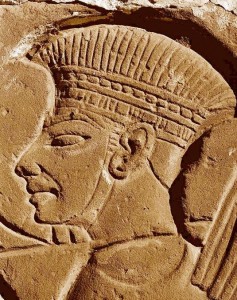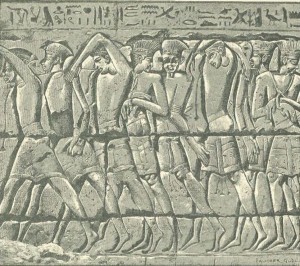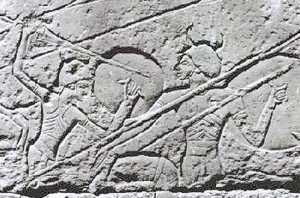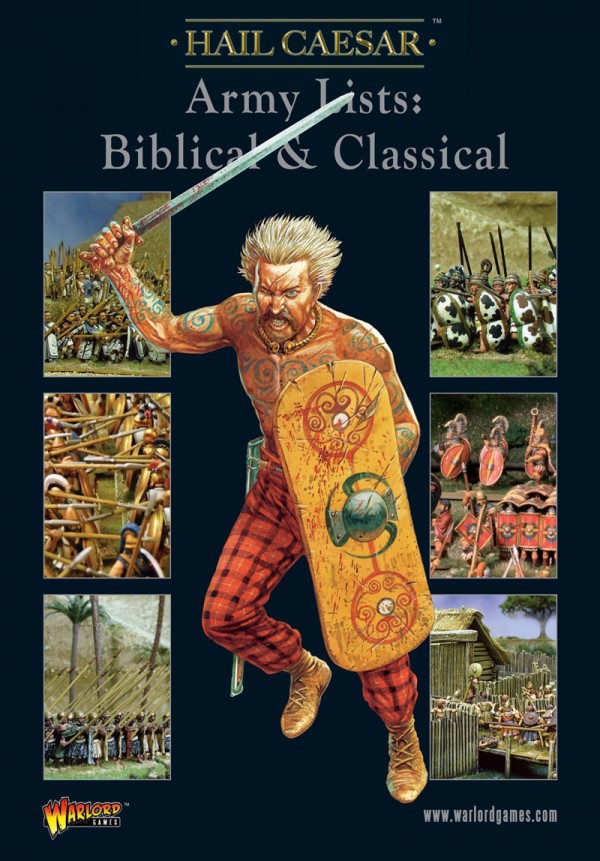The Late Bronze Age is the age of chariot warfare and of the great warrior pharaohs. When film and TV conjure images of ancient Egypt they inevitably draw upon the world of the late Bronze Age to do so. It is also the age of the Mycenean civilisation of Greece and the mighty cyclopean ruins of cities such as Tiryns and Mycene itself. Everyone knows of the ruins of Knossos and the cities of Crete – these too belong to the Late Bronze Age. Less well known perhaps are the Hittites – whose rulers were the equals and rivals of the pharaohs, and whose empire stretched across Anatolia and Syria. These were mighty civilisations of the Late Bronze Age. All were to collapse at the end of the Bronze Age amidst invasion, upheaval, devastation and ruin. Many cities were burned and abandoned never to be resettled. Others were attacked and destroyed, but subsequently resettled by new inhabitants with new and different ways. Across the Near East no one entirely avoided the calamity, although the Assyrians – living away from the coasts, led by strong kings and possessing a powerful army, escaped the wholesale destruction visited upon their neighbours.

Sea Peoples from the Medinet Habu temple relief
This great period of upheaval and destruction is known as the Late Bronze Age Collapse – and it was the culmination of a period of instability during which the eastern Mediterranean was subject to raids and invasion from many different tribes that the Egyptians referred to collectively as The Sea Peoples (more literally the Peoples of the Sea as opposed to the Peoples of the Land). This is what Ramesses III (c1175BC) has to say about the Sea Peoples as recorded on his mortuary temple as Medinet Habu.
‘The foreign countries made a conspiracy in their islands. All at once the lands were removed and scattered in the fray. No land could stand before their arms. From Hatti, Qode, Carchemish, Arzawa and Alashiya on, being cut off one at a time. A camp was set upon in Amurru. They desolated its people, and its land was like that which has never come into being. They were coming forward towards Egypt, while the flame was prepared before them. Their confederation was the Peleset, Tjeker, Shekelesh, Denyen and Weshwesh – lands united. They laid their hands upon the land as far as the circuit of the earth, their hearts confident and thrusting, ‘our plans will succeed’.
By the time of Rameses III these Sea Peoples had already been raiding and trouble-making for a least a hundred years. Indeed, Rameses II fought a famous battle against sea raiders named as the Sherden, Lukka and Shekelesh. After defeating them he evidently took some of the Sherden into the Royal Guard, for Sherden are depicted in reliefs of the Battle of Kadesh, showing their distinctive horned helmets topped with a ball. His son Merneptah was faced with an alliance of Libyans and Sea Peoples – an account of his battle against them is preserved on the sixth pylon at Karnak.
“The wretched, fallen chief of Libya, Meryre, son of Ded, has fallen upon the country of Tehenu with his bowmen–Sherden, Shekelesh, Ekwesh, Lukka, Teresh, Taking the best of every warrior and every man of war of his country. He has brought his wife and his children–leaders of the camp, and he has reached the western boundary in the fields of Perire.”
The battle of Perire took place in the western delta and resulted in the defeat of the Libyan/Sea Peoples alliance with 6,000 dead and 9,000 taken prisoner.

Sea People Captives from Medinet Habu
So who were these Sea Peoples – these Sherden, Shekelesh, Ekwesh, Lukka Teresh, Peleset, Tjekker, Denyen and Weshesh? No one knows for certain, but the Egyptians name them all as northerners, and often as islanders who are accomplished sea raiders and dangerous warriors. They appear to have been instrumental in the destruction of the Hittite Empire, and the cities of Syria and Cannan, and during the time of Rameses III they came as settlers with their womenfolk and children.
In many ways there is a parallel between the Sea Peoples and the Barbarian invasions that brought the Roman Empire to an end. Just like the barbarians of the fourth and fifth centuries AD, the Sea Peoples are not a single people but a multitude of tribes and allies, some of whom were probably closely related and others not. The chances are that they had been driven southwards in their turn by a combination of famine caused by drought, and pressure from nomads moving south as grasslands became increasingly arid. At this time the climate became significantly drier throughout the Mediterranean causing widespread famine, weakening the empires of the Late Bronze Age. This led to outbreaks of plague, dissent, civil wars and depopulation. This was certainly the case amongst the Hittites, whose last Kings were reduced to begging grain shipments from the Pharoahs to try and avoid starvation.
In this new world of hunger and civil breakdown the Sea Peoples were able to move in, at first as raiders, and eventually as occupiers and settlers. They often acted with others of their ilk, or made alliances with peoples such as the Libyans and maybe the Gaska in Anatolia – age old enemies of the Egyptians and Hittites respectively. Some of them hired into other armies of the period, including the Sherden of Rameses III.

Sherden depicted at Medinet Habu – note that they appear to be fighting on both sides!
This is a list of the Sea Peoples, as named by the Egyptians, and the associations made with them by modern scholars. Remember that the names are transcriptions of Egyptian hieroglyphs – so the inclusion of ‘e’ as a vowel is a modern convention (hieroglyphs are written in consonants or syllables without vowels – ‘Peleset’ is a rendering of p-l-s-t… and so on).
Peleset – long since identified with the Philistines of the Bible (Greek Pelastoi, Hebrew Pilishtim). Probably from western Anatolia and the Aegean and possibly to be identified with the Pelasgians – an autochthonous people of Anatolia.
Teresh – probably from north western Anatolia – possibly even the inhabitants of Taruisha mentioned in Hittite texts.
Ekwesh – identified with the Akhiyawa of Hittites tests – the Akhaiwoi of Homer or Achaeans. Which would make them Mycenean Greeks.
Tjekker – probably the Teukeroi of Greek tradition associated with the settlement of Enkomi in Cyprus but originally from the Aegean region or Greece itself.
Weshesh – we could identify these people with the region of Caria (the south-west tip of Anatolia) known as Oussos. Alternatively we might consider the name to derive from Assuwa – a region further to the north of the west coast of Anatolia. This is the region that became known as Asia in Classical times. However, this is mere speculation.
Skekelesh – it is a reasonable bet that these are the Homeric Sikeloi or Sikels of later times. Sicily is named after them. However, that doesn’t mean they came from Sicily – only that they eventually settled there and gave their name to the island. Exactly where they came from if therefore a mystery – although we might hazard to identify them with the Sagalassan pirates, which would place them along the southern coast of Anatolia in the region the Greeks called Pamphylia.
Sherden – usually identified with the areas around Sardis, itself part of the greater region of Arzawa of Hittite record. The King of Arzawa was accorded the status of Great King by both Hitties and Egyptians, so it must have been a considerable power in its own right. This region in western Anatolia was later known as Lydia. They give their name to Sardinia where at least some of them eventually settled (a pronunciation closer to Shardana is likely).
Lukka – in this case we are on fairly safe ground – the Hittites identify the Lukka lands as lying upon the western Anatolian coast in the region of Lycia (Greek Lykioi) and its capital city of Xanthus.
Denyen – another rendering would be Danuna which suggests the ancient Greek Dardanoi or Danaans. David Rohl makes a case for identifying them with the region of Cilicia in south east Anatolia and the island of Cyprus – named in Assyrian texts as Yadana – the Island of the Danana.
In Hail Caesar we have a list for the Sea Peoples, which covers the invasions of the 12th century BC and makes provision for all the different allies. This can be found in Hail Caesar Army Lists: Biblical and Classical.

